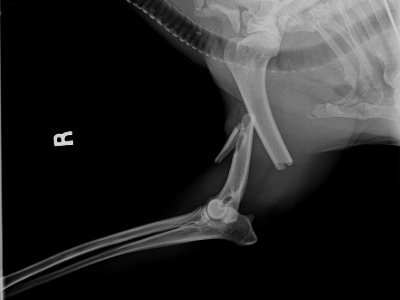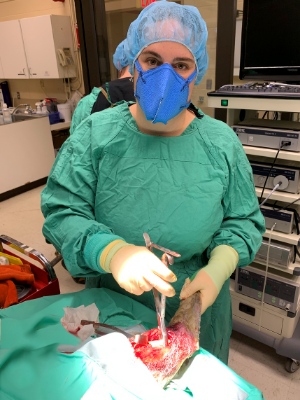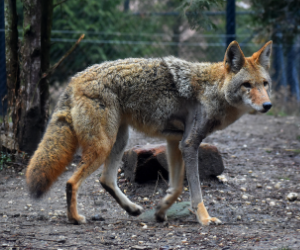Coyotes as a species are some of the most versatile and resilient members of the animal kingdom. These canines have been known to make their home anywhere from the hottest deserts, to the frozen mountains, and even in our own backyards! They are both clever and skilled at survival, which is why many myths and stories describe them as cunning or wily. However, being brainy doesn’t make coyotes any less playful or fun loving. In fact, coyotes have been known to run around and play well into their adulthood, unlike many other animals who outgrow most playful behaviors as they get older. Of course, sometimes playing too hard can lead to trouble; a lesson our male coyote, Shilah, learned all too well.
Our story begins last Thanksgiving. As many of you were roasting turkeys or settling in to watch the big game, the Akron Zoo coyotes were doing what they love most: running. Shilah and Kaliska are seven-year-old siblings who moved to the zoo in 2013. Since they were pups, the two have always enjoyed playing together and racing around their habitat. Unfortunately, on this particular day, the two had been running in different directions, and Shilah failed to notice his sister coming at him around a blind curve. The two accidentally crashed into one another, and Kaliska’s head slammed into Shilah’s right leg.
 Keepers noticed immediately that Shilah was injured and called veterinary staff to come evaluate the injury. Shilah was then transported to our animal hospital where he was placed under anesthesia, an exam was performed, and radiographs were taken to assess the damage. Once this was complete, Dr. Brittany Rizzo and Dr. Steven Faust began the surgery.
Keepers noticed immediately that Shilah was injured and called veterinary staff to come evaluate the injury. Shilah was then transported to our animal hospital where he was placed under anesthesia, an exam was performed, and radiographs were taken to assess the damage. Once this was complete, Dr. Brittany Rizzo and Dr. Steven Faust began the surgery.
“It was easy to see and feel right away that the humerus (the bone in the upper leg) was fractured. Luckily, animals in accredited AZA institutions have wonderful care teams, clean and enriching habitats, and are protected from things like predators and cars, so injuries like this are much less common compared to animals in their native habitat, or even in pets like dogs and cats. That being said, accidents happen from time to time and this was one of them,” says Rizzo. “Once we had him under anesthesia, radiographs helped us confirm where and how the bone was broken, as well as how many fragments there were. Unfortunately, it was hard to assess the level of muscle and nerve damage until you start the surgery.”
 “Overall, the procedure went well and vet staff managed to repair the bone. While Shilah had some significant muscle damage, his major nerves were still intact, meaning he wouldn’t lose sensation and/or function in his leg. This was great news because muscles can heal fairly quickly, but nerves can take months to heal, if at all,” she continued. “When all was said and done, the repair required an intramedullary pin (a long pin that runs down the inside of the bone), two wires to hold the smallest fragment of bone in place, and then a bone plate with five screws to hold all the pieces together. This combination of equipment protects the bone from bending and twisting while it heals, yet doesn’t require any external metal that an animal like a coyote may not tolerate very well.”
“Overall, the procedure went well and vet staff managed to repair the bone. While Shilah had some significant muscle damage, his major nerves were still intact, meaning he wouldn’t lose sensation and/or function in his leg. This was great news because muscles can heal fairly quickly, but nerves can take months to heal, if at all,” she continued. “When all was said and done, the repair required an intramedullary pin (a long pin that runs down the inside of the bone), two wires to hold the smallest fragment of bone in place, and then a bone plate with five screws to hold all the pieces together. This combination of equipment protects the bone from bending and twisting while it heals, yet doesn’t require any external metal that an animal like a coyote may not tolerate very well.”
Keepers and vet staff knew that Shilah would be the most comfortable recovering in his own bedroom, so following the surgery; he was moved back to Grizzly Ridge.
“Shilah was up and walking around that very same evening and he’s been doing well ever since!” says Rizzo. “Coyotes love to run around, so the hardest part of his recovery has actually been trying to encourage him to rest. We needed to do everything we could to keep him calm and allow the bone to heal correctly.”
 Shilah remained inside for 5-6 weeks before making it known to his keepers that he wanted to go back outside. In order to make this transition as safe as possible, keepers removed all logs, large rocks, and other trip hazards from the habitat and provided several places to rest and several forms of enrichment that would encourage rest and relaxation. In addition, the guest pathway near the coyote habitat was closed, and staff have been asked to keep traffic in the nearby behind-the-scenes areas to a minimum. Vet staff is optimistic that, by lowering the stimulation in his environment, Shilah will get more rest and he will continue to recover.
Shilah remained inside for 5-6 weeks before making it known to his keepers that he wanted to go back outside. In order to make this transition as safe as possible, keepers removed all logs, large rocks, and other trip hazards from the habitat and provided several places to rest and several forms of enrichment that would encourage rest and relaxation. In addition, the guest pathway near the coyote habitat was closed, and staff have been asked to keep traffic in the nearby behind-the-scenes areas to a minimum. Vet staff is optimistic that, by lowering the stimulation in his environment, Shilah will get more rest and he will continue to recover.
“We will be scheduling an exam within the next month to recheck his radiographs, see how the bone is healing, and potentially remove the intramedullary pin,” says Rizzo. “As long as the bone heals well, the rest of the metal will likely stay in place indefinitely. I want to send a big shout out to all the keeping staff, animal care management, and veterinary staff that has worked so hard to get him to this point in his recovery. It’s truly appreciated and he’s doing great because of you!”
Great work vet team and get well soon Shilah! Keep an eye on social media for more Akron Zoo inside looks and updates, or drop in to visit more than 1,000 unique animals from around the world. We hope to see you soon!
